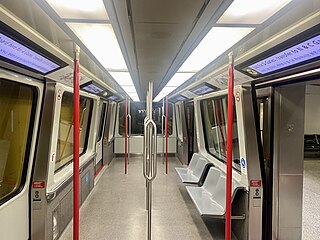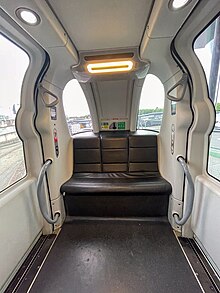
Personal rapid transit (PRT), also referred to as podcars or guided/railed taxis, is a public transport mode featuring small low-capacity automated vehicles operating on a network of specially built guideways. PRT is a type of automated guideway transit (AGT), a class of system which also includes larger vehicles all the way to small subway systems. In terms of routing, it tends towards personal public transport systems.

A people mover or automated people mover (APM) is a type of small scale automated guideway transit system. The term is generally used only to describe systems serving relatively small areas such as airports, downtown districts or theme parks.

An automated guideway transit (AGT) or automated fixed-guideway transit or automatic guideway transit system is a type of fixed guideway transit infrastructure with a riding or suspension track that supports and physically guides one or more driverless vehicles along its length. The vehicles are often rubber tired or steel wheeled, but other traction systems including air cushion, suspended monorail and maglev have been implemented. The guideway provides both physical support, like a road, as well as the guidance.
Various terms are used for passenger railway lines and equipment; the usage of these terms differs substantially between areas:
Cabinentaxi, sometimes Cabintaxi in English, was a German people mover development project undertaken by Demag and Messerschmitt-Bölkow-Blohm with funding and support from the Bundesministerium für Forschung und Technologie. Cabinentaxi was designed to offer low-cost mass transit services where conventional systems, like a metro, would be too expensive to deploy due to low ridership or high capital costs.

Morgantown Personal Rapid Transit is a personal rapid transit (PRT) system in Morgantown, West Virginia, United States. The system connects the three Morgantown campuses of West Virginia University (WVU) and the city's downtown area.

The Terminal Link is an automated people mover (APM) at Toronto Pearson International Airport in Mississauga, Ontario, Canada. The wheelchair-accessible train runs 24 hours a day, seven days a week and is completely free-of-charge to ride. In 2012, it transported 17,000 passengers daily, 60 to 70% of whom were airport staff.

London has an extensive and developed transport network which includes both public and private services. Journeys made by public transport systems account for 37% of London's journeys while private services accounted for 36% of journeys, walking 24% and cycling 2%,according to numbers from 2017. London's public transport network serves as the central hub for the United Kingdom in rail, air and road transport.

The SEA Underground, formerly called the Satellite Transit System (STS), is an automated people mover (APM) system operating in the Seattle–Tacoma International Airport in SeaTac, Washington, United States. Originally opening in 1973, the SEA Underground is one of the oldest airport people mover systems in the world. The APM was designed to quickly transport passengers to and from the North and South Satellites, and around the airport's Main Terminal.

Heathrow Terminal 5 is an airport terminal at Heathrow Airport, the main airport serving London. Opened in 2008, the main building in the complex is the largest free-standing structure in the United Kingdom. Until 2012 the terminal was used solely by British Airways. It was then exclusively used as one of the three global hubs of IAG, served by British Airways and Iberia until 12 July 2022, when Iberia moved all flights to Terminal 3, leaving British Airways as sole user again.

The Stansted Airport Track Transit System (TTS) is a fully automated people mover system which operates within London Stansted Airport in the United Kingdom.

LTV's (Vought) Airtrans was an automated people mover system that operated at Dallas/Fort Worth International Airport between 1974 and 2005. The adaptable people mover was utilized for several separate systems: the Airport Train, Employee Train, American Airlines TrAAin and utility service. All systems utilized the same guideways and vehicle base but served different stations to create various routes.
Braniff Jetrail Fastpark System was a suspended monorail system that operated at Dallas Love Field in Dallas, Texas, United States, from April 18, 1970, until January 13, 1974. It was built by Stanray Corporation, Chicago, Illinois, for and operated by Braniff International Airways to transport passengers and their luggage from remote parking lots to the airport terminal.
The Alden staRRcar, short for "Self-Transport Road and Rail Car", was a personal rapid transit (PRT) system designed by William Alden in the 1960s. It originally envisioned small electrically powered cars suitable for short distance trips at low speed within urban areas, which could optionally merge onto tracks that would provide power and guidance for high-speed travel over longer inter-city distances. It was one of the earliest dual-mode vehicles to be proposed, and one of the earliest to be actually built.
Minitram was an automated guideway transit system studied by the Transport and Road Research Laboratory (TRRL), part of the UK Department of the Environment's Ministry of Transport. The system was based on small, completely automated tram-like vehicles of about 25 passengers that could be connected together into three-car trains to increase capacity. Proposed designs were submitted by Hawker Siddeley Dynamics (HSD) and EASAMS. HSD's system used rubber wheels and EASAMS' steerable steel ones, but the projects were otherwise similar and notably shared a linear motor for propulsion and most braking. A series of failed sales efforts in the UK and to the GO-Urban system in Toronto, combined with decreased government spending in the 1970s, led to the concept being abandoned.

The Oakland Airport Connector is an automated guideway transit (AGT) system operated by Bay Area Rapid Transit (BART) between BART's Coliseum station and Oakland International Airport station. The line is colored on BART maps as the Beige Line. The system is integrated into BART's fare system. The line opened for revenue service on November 22, 2014, replacing the AirBART shuttle bus service that had operated since July 1, 1977. Currently operating between two terminal stations, the system includes provisions for an intermediate third station that may be built at a later date.

The Gatwick Airport Shuttle Transit is a 0.75-mile (1.21 km) long elevated automated people mover that links the North and South Terminals at London's Gatwick Airport. The line is ground-side, and besides linking the two terminals also serves to link the North terminal to the airport railway station. Although sometimes colloquially, but erroneously, known as a "monorail", the transit vehicles are carried on rubber tyres running on a concrete track with twin running surfaces and are steered by separate guide rails.

The Heathrow Terminal 5 Transit is an automated people mover system (APM) at London Heathrow Airport in the United Kingdom. It operates in the Heathrow Terminal 5 complex and conveys air passengers between the main airport terminal and its satellite buildings, Terminals 5B and 5C.
In the 1990s, the Regional Transportation Authority (RTA) planned to fund the construction of a personal rapid transit (PRT) system in Rosemont, Illinois. Raytheon had been contracted to build the system. The project was cancelled in October 1999. Rosemont had been selected in 1993 by the RTA be home to a demonstration PRT system. Five other municipalities in the suburban Chicago metropolitan area had submitted unsuccessful bids to be host to the PRT project. The system would have been the first-of-its-kind, utilizing smaller vehicles than the existing Morgantown Personal Rapid Transit. The project marked the first serious activity related to PRT construction since Morgantown Personal Rapid Transit.

















